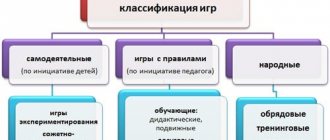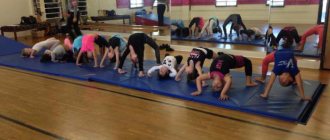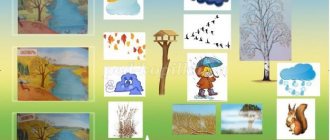GCD according to the Federal State Educational Standard educational and methodological material (junior group) on the topic
The structure of writing GCD taking into account the Federal State Educational Standard
To properly organize GCD, you need to have a good understanding of some issues and identify the difference between “occupation” and “GCD”.
The distinctive features of GCD are primarily
-forms of its organization
- in changing the position of the teacher in relation to children
-updating the structure of the GCD.
Initially, you need to think about the motivation with which GCD begins.
Motivation can be different - practical, playful, educational. It should contain something that will cause interest, surprise, amazement, delight in children, in a word, then after which the children will want to do “this.”
And so the structure of GCD
Introductory part.
1) Creation of a game situation (problem situation, target setting, any motivation that stimulates children’s activity in finding a solution to it.
MAIN PART
2) designing solutions to a problem situation, performing actions. Children are given new knowledge necessary to solve a problematic issue based on the content of different sections of the program based on visualization, or children themselves obtain knowledge through research, search, and discovery.
FINAL PART,
3)Analysis of performance results, reflection. Summarizing.
Introductory part of GCD, features of work on creating play motivation at different age stages.
Younger age - you tell the children that something happened to some game characters, you turn to the children with a question, we agree
If they provide the required assistance, you gradually offer your children your
options for getting out of this situation...
Middle group - you can bring a character because at this age children have already mastered roles or children take on a role and act in it. To do this, the teacher invites the children to play. Then, together with the children acting in the role, first a game task is set (we need to do something, and then a learning task (we will learn how to do it).
The older group - the main thing is not the characters, but the plots, plot structures (there is no character himself, but there is a letter, an SMS, a call). Plots can be long (travel in a time machine). During the GCD may
Use small paraphernalia, established roles, changing
Roles.
In the preparatory group, the need to create play motivation remains, but here problem situations can already be added.
A problematic situation is a planned, specially conceived means by the teacher aimed at awakening children’s interest in the topic under discussion. In other words, a problematic situation is a situation in which a child wants to solve difficult problems, but he lacks data and must look for it himself.
You can also use games with rules as motivation; children make sure the rules are followed. The game used is a competition with the goal of winning. Give every child the opportunity to visit the world
situations of winning and losing.
MAIN PART
Having outlined a task for joint implementation (children choose a goal or several goals for themselves, the adult, as an equal participant, offers all possible ways to implement it. In the process of activity itself, he gradually “sets” the developmental content, offers his idea or his result for children’s criticism; shows interest as a result of others; is included in the mutual assessment and interpretation of the actions of the participants; increases the child’s interest in the work of a peer, encourages meaningful communication, provokes mutual assessments, and discussion of emerging problems.
Do not evaluate children's answers - accept any. During the activity, V-l always asks the children “Why, why are you doing this, so that the child comprehends every step. If a child does something wrong, give him the opportunity to understand for himself: “What exactly is wrong, you can send a smarter child to help.
FINAL PART
Results and reflection, up to 5 minutes.
First of all, this part is characterized by an “open end”; Each child works at his own pace and decides for himself whether he has completed the research or work or not. An adult's assessment of children's actions can only be given indirectly, as a comparison of the result with the child's goal: that is, what he wanted to do - what happened.
Don’t ask your children: did you like it or not? We need to ask “why did you do this? To understand whether the child has realized the goal. Or “Why did you need this? “Could you ever need this?”
Find someone to praise for something, not only for the result, but also for the activity in the process of work. The assessment must be differentiated.
When organizing educational activities, the professional position of the teacher is to respect any statement of the child regarding the content of the topic under discussion. We need to think in advance about how to discuss children’s versions, not in a harsh, evaluative form
A new GCD model plan that will save teachers from taking long notes
Educators must organize continuous educational activities (CED) in accordance with the requirements of the Federal State Educational Standard for Educational Education - in the form of joint partnership activities between an adult and children. However, the teacher often remains the only central figure in the course of educational activities. This is also indicated by the fact that the level of speech activity of children remains low even during speech development classes. The reason for this, to a large extent, is that educators traditionally use detailed notes from educational activities, where the picture of the lesson is built in the smallest detail, right down to the children’s possible answers. Sometimes the teacher does not allow the children to speak out because they are afraid that they will not have time to accomplish what they have planned. But the goal of GCD is to develop children, and not to carry out a planned script.
We suggest using a GCD plan model in your work. It gives an idea of the idea and logic of educational activities, reflects the sequence of actions and dialogue with children, but does not limit the teacher and children in improvisation, ideas, free choice and communication.
The plan-model of continuous educational activities takes from 2/3 to 1 page in volume. It does not contain educational material, poems, riddles, or games. The teacher takes them from card files and books, if necessary. It is easier for a teacher to retain such a plan in memory than a detailed outline or script. Writing such a plan takes less time on paperwork, which allows you to quickly prepare for educational activities.
The model plan is universal - another teacher can use it: take an idea and develop it at his own discretion.
What structure does the plan model have?
The model plan is of a framework nature, so it describes only the main elements of the GCD:
- stages of GCD, including goal setting;
- key issues;
- the situation of choice is an element of partnership interaction.
Goal setting. Here we mean the goal that the teacher sets for himself, i.e. this is the goal of educational activity. The model plan also includes a goal-setting step for children.
An example of GCD goal setting
The purpose of the GCD must be relevant. For example, a teacher organizes research activities in order to expand children’s understanding of an object or phenomenon. But preschoolers cannot work together: they conflict and cannot agree. What conclusion can be drawn? At this stage, it is more important to develop conflict-free communication skills in this particular group. That is, the goal of GCD is to organize a situation in which children develop conflict-free communication skills.
The modern educational process in preschool educational institutions should be variable and flexible. The teacher can build it taking into account the characteristics of the group and specific children.
The goal must be specific. It is advisable to have one goal. A common mistake of educators is the desire to embrace the immensity. They set so many goals for themselves that it is impossible to achieve them in the period of time allotted for educational activities. After all, it is necessary not only to realize the set goal, but also to monitor how successfully it is achieved. This does not mean that in the process of ECD, students develop only in one direction. Integration has deeply penetrated the educational process, and children develop in different directions. But teaching activities during educational activities will become more effective if the teacher focuses on one specific goal.
The goal must be measurable. The teacher will not be able to “measure” the achievement of 4-5 goals when conducting pedagogical observation. For example, how many children have made progress in mastering a skill? What level of independence do children show when completing practical tasks? How many children in the group follow the rules? And he can determine whether one goal has been achieved.
The goal must be achievable and related to a specific time frame. When a teacher plans educational activities, there is no need to set strategic goals. For example, it is impossible to develop cognitive interest in children in 20 minutes, but you can create conditions for this, organize an educational situation for the development of cognitive interest. In a subsequent analysis, the teacher will be able to list these conditions and confirm that the goal of the GCD has been achieved.
The goal of the GCD must be related to the goal of a higher order. The main principle of the planning system is to follow from strategic goals (targets) to tactical ones, from annual goals to monthly, weekly goals, specific goals and objectives of each educational activity. Goals and objectives must be interconnected.
GCD objectives should reflect the steps that the teacher plans to take to achieve the goal. Often, teachers’ tasks are the same goals, sometimes even broader than the goal itself, which is illogical. It is also wrong to replace goals and objectives with program content. Pedagogical activity cannot be aimless.
If goals and objectives are defined correctly, they can give a general idea of the planned GCD.
Motivation. Organization of the motivational stage also causes difficulties for educators. This can be judged by how monotonous the techniques they use in their notes are.
Teachers who work with preschool children must study methodological literature, the experience of colleagues, apply a creative approach to the process in order to evoke a lively response and genuine interest from students, and captivate them with various types of activities. It’s difficult to come up with an effective, motivating and mobilizing beginning every time, but you need to strive for this. Voluntary attention is just being formed in preschool age, and the teacher needs to try to ensure that the motive for children’s participation in educational activities is their direct interest, and not the instructions of an adult.
To do this, you need to constantly replenish your repertoire of motivational techniques. For each technique, you can come up with a short name so as not to describe it in detail in the plan.
Key questions. Key questions give the overall logic of the GCD. These are several related questions that encourage children to engage in productive dialogue. Their number is 4–5, sometimes more. They make you think, reason, act and ultimately lead to results.
Questions can be motivating (encouraging action), guiding, problematic, evaluative and reflective.
Most often, most of the questions that a teacher asks children are reproductive in nature, that is, the child is required to remember something, reproduce what he was taught. Such questions are also needed. But every GCD must also have open questions - those that imply detailed answers and their different options. This is especially important for older preschoolers. The more the teacher asks open-ended questions, the more interesting the dialogue he will build with the children.
The wording of key questions should be concise, clear and understandable. During the GCD, if the children do not immediately grasp the essence of the question, it is better to repeat it several times, addressing directly to individual students, rather than reformulating the question each time, confusing the children. You just need to give them time to think.
During the dialogue there will be more questions and answers, opinions, statements and reasoning from the teacher and children. But it is impossible and unnecessary to plan and register all of them if the teacher strives for free communication.
Collaboration. At this stage, as at the next, the teacher provides for the situation of choosing materials, type of activity, partner for activity and communication. Even if he does not provide the child with a wide choice, but only two options, this will allow the preschooler to make his own decision.
Independent work of children. This stage may not be reflected in the plan if the teacher does not expect independent work. It depends on the purpose of the GCD. But if he plans it, he must define his role at this stage. The teacher can:
- conduct individual work with children who need help;
- continue the dialogue with all students on the topic of GCD;
- give additional information;
- make notes to later add them to individual observation cards.
Reflection is the last and obligatory stage of GCD. Forming reflective skills as indicators of children’s personal growth is an important task for the educator. At the end of the educational activity, one can and should discuss:
- result - does it correspond to the goal, expectations at the beginning of the GCD (it can be collective (Did we succeed?) and individual (Did you succeed?);
- points that require correction (What would you like to correct?);
- content (What did you learn? What will you tell us about at home?);
- methods, sequence of activities (How did you achieve the result?)
- interaction during activities: attention to the interests of others, mutual assistance;
- attitude to what is happening, emotional background (what mood did you work in?);
- prospects for activity (What else can be done? What else would you like to do? Find out? Which method would you choose next time?).
GCD model plan template
HOW TO WATCH THE PRESENTATION
Scroll through the presentation by clicking the mouse, or use the arrows below
Electronic presentation about the GCD plan model
To make it more convenient for you to introduce educators to the GCD model plan, use comments on the slides.
What determines the volume of the model plan?
The GCD plan model, compared to the outline, has a more concise form. But even here the volume may vary. This depends on the purpose of the educational activity, its duration in different age groups, on the number of stages and their sequence, on the content of the activity and other factors, such as the teacher’s own understanding of what is the priority of a particular educational activity.
As an example, Appendices 1–2 present examples of GCD model plans on the topics “All work is honorable” in the senior group and “Why does a hare have long ears?” in the preparatory group.
Should I give up taking notes altogether?
There is no need to completely abandon notes and technological maps. With the help of technology maps, young teachers will be able to better understand the structure of teaching activities. They will also come in handy when educators learn new educational technologies.
A teacher needs a detailed outline of continuous educational activities to submit his work to a competition or publish it in a professional publication.
For daily work, a compact plan of educational activities is sufficient, which sets the main direction of the educational activity and gives the teacher and children the opportunity to improvise and communicate freely.
Annex 1
An example of a GCD model plan on the topic “All work is honorable”
Age group: senior.
Goal: to instill in children respect for the people who work in kindergarten and their work.
Tasks:
- clarify children’s ideas about the professions of kindergarten employees;
- pay attention to the features of these professions, show why they are interesting;
- create a situation in which children will show kindness, express gratitude and respect towards the kindergarten staff;
- lead to the conclusion that all professions are important.
Fragment of the NOD “All work is honorable” (E. Belozerova, teacher at MBDOU “Kindergarten No. 3” in Kalachinsk)
Appendix 2
An example of a GCD model plan on the topic “Why does a hare have long ears?”
Age group: preparatory.
Goals:
- to develop in children the ability to ask questions for cognitive purposes and experimentally find answers to them;
- expand children's understanding of the world around them;
- develop research skills.
Tasks:
- continue working with pictogram diagrams to formulate questions and draw conclusions;
- conduct experiments that demonstrate the functions of the hare's ear;
- record on an observation sheet how the ability to ask questions for educational purposes is being developed in the group’s students.
Fragment of the GCD “Why does a hare need ears?” (S. Trushina, senior teacher of MBDOU “Kindergarten No. 5” in Kalachinsk)
+
Notes on pedagogy “Types of GCD. requirements for the abstract of GCD."
Types of GCD. requirements for the abstract of GCD.
Types of classes: classical, comprehensive, thematic, final, excursions, group, games, labor.
A classic lesson in a preschool educational institution has the following features:
— Structure of a classical lesson;
— Start of class;
— Involves organizing children.
Switching children's attention to the upcoming activity, stimulating interest in it, creating an emotional mood, precise and clear instructions for the upcoming activity (sequence of task completion, expected results).
Progress (process) of the lesson:
Independent mental and practical activity of children, fulfillment of all assigned educational tasks.
During this part of the lesson, individualization of training is carried out (minimal assistance, advice, reminders, leading questions, demonstration, additional explanation). The teacher creates conditions for each child to achieve results.
End of class:
Dedicated to summing up and assessing the results of educational activities. In the younger group, the teacher praises for diligence, the desire to complete the work, and activates positive emotions. In the middle group, he takes a differentiated approach to assessing the results of children’s activities. In the senior and preparatory school groups, children are involved in the assessment and self-assessment of results.
Depending on the section of training and the goals of the lesson, the methodology for conducting each part of the lesson may be different. Private methods provide more specific recommendations for conducting each part of the lesson. After the lesson, the teacher analyzes its effectiveness, the children’s mastery of program tasks, reflects on the activity and outlines the prospects for the activity.
Complex - the implementation of tasks through different types of activities with associative connections between them (a conversation about fire safety rules turns into drawing a poster on the topic). At the same time, one type of activity dominates, and the second complements it and creates an emotional mood.
A complex activity is one aimed at a comprehensive disclosure of the essence of a certain topic through different types of activities that consistently change each other.
Integrated - combine knowledge from different educational fields on an equal basis, complementing each other (considering such a concept as “mood” through works of music, literature, painting).
1. Classic lesson
According to the old classic form: explanation, completion of the task by children. Results of the lesson.
2. Complex (combined lesson)
Using different types of activities in one lesson: artistic expression, music, visual arts, mathematics, design, manual labor (in different combinations).
3. Thematic lesson
It can be complex, but subordinated to one theme, for example, “Spring”, “What is good”, “our toys”, etc.
4. Final or test lesson
Finding out how children have mastered the program over a certain period of time (six months, quarter, academic year).
5. Excursion
To the library, studio, post office, field, construction site, school, etc.
6. Collective creative work
Collective drawing, collective application: building a street in our city.
7. Occupation-work
Planting onions, cuttings of plants, planting seeds, etc.
8. Activity-game
“Toy store”, “Let’s arrange a room for the doll.” Option: Auction activity - whoever tells the most about the item buys it.
9.Creativity activity
Workshop of an artist, folk craftsmen, storyteller, “Workshop of Good Deeds” (crafts made from waste, natural materials, paper using TRIZ elements).
10. Gathering activity
Based on folklore material, against the backdrop of work, children sing, make riddles, tell fairy tales, and dance in circles.
11. Lesson-fairy tale
The entire lesson is based on the plot of one fairy tale, using music, visual arts, and dramatization.
12. Lesson press conference
Children ask questions to the “astronaut”, “traveler”, “fairy tale hero” and he answers the questions, then the “Journalists” draw and write down what interests them.
13. Landing lesson
Urgent Care. Example. We go from the opposite: during drawing, we ask children about what they can’t do or do poorly. Today we will draw this, those who are good at it will help us. Option: joint activity of children of the older and younger groups (co-creation). The older ones, for example, make the background, the younger ones draw what they can.
14. Commented training session
The whole group of children is given the task of forming the number “7”. One of the children speaks out loud how he makes up a given number, the rest silently do it; if the speaker makes a mistake, a discussion begins. Options: the teacher draws on the board, the children comment on the image, make up a story, or the teacher draws what the children are talking about.
15. Travel activity
The goal is to develop children's monologue speech. One of the children is a “tour guide”, the rest of the children ask questions. Options: travel through fairy tales, native country, city, republic, to the “Land of Cheerful Mathematicians”, according to the “Red Book”.
16. Discovery lesson (problem lesson)
The teacher offers the children a problem situation, the children solve it together and make a discovery. Example: “What happens if paper disappears?”, “Why study?” Option: “The investigation is being conducted by experts.”
17. Lesson-experiment
For example, a child is given paper. He does not do everything he wants with him - tears, crumples, wets, etc. Then he draws his own conclusion. Options: with ice, snow, magnet, air.
18. Activities-drawings-essays
The teacher draws, the children make up stories. Children make up stories based on their drawings. Children “write” a letter-drawing about an event in kindergarten.
19. Lesson-competition
Like: “What, where, when?” Competition of dreamers, poems, fairy tales.
Children are divided into teams, issues are discussed together, the captain speaks, and the children complement.
20. Group classes (competition option)
Children are organized into groups. For example, for 4 seasons. They prepare for the lesson in secret. During the lesson they talk, “defend” their season, draw, and tell invented stories. The winner is the one who makes the most interesting speech defending his season (books, toys, etc.).
21. “Game-school”
School for astronauts (athletes), school for forest dwellers (animals), school for young drivers and pedestrians. They talk about themselves, sing, dance, pantomime, etc.
GCD summary:
1. Heading. It is not necessary to write the name of the educational activity in the title (for example, a summary of the educational activity “Visiting Parsley”). You can simply indicate the direction of activity (“Summary of direct educational activities on cognitive development”). Write the age (group) of the children (for children of senior preschool age).
2. After the title, you can indicate the priority educational area in the GCD process and, preferably, integration with other educational areas, as well as the integration of children's activities.
3. The forms of organizing collective activities are indicated (work in subgroups, in pairs, joint activities of the teacher with children) and independent activities of children (if planned).
4. Further indicate: material and equipment; preliminary work; planned results.
5. Tasks. I would like to immediately warn teachers against making mistakes. Some colleagues write: “GCD goals.” This is methodologically incorrect. The goal is the final and overall result, extended over time. What goal can be achieved, for example, in 15 minutes of educational activity in a younger group? It is more correct to write the word “goal”, for example, when developing planning for a complex (i.e., several) GCD, when developing a project (since it is multifaceted) and other time-extended complexes of educational activities. Moreover, there is only one goal, but there can be many tasks.
And for a specific educational activity, specific tasks are suitable that must be solved by the end of this educational activity (after 15 minutes in the junior group or after 35 minutes in the preparatory group). That is, if a teacher wrote a problem in the GCD notes, then he must solve it in the GCD process. Therefore, do not write 10-15 problems in your notes. Five, maximum six is enough.
6. The progress of direct educational activities. I reflected the main points of the educational activity itself in the article “How to develop a developmental lesson,” since any educational activity according to the Federal State Educational Standard should be developmental.
Introductory part (motivational stage). The teacher must motivate children to engage in cognitive (or play) activities using a problem or play situation. This situation is described in the outline.
The main part (content, activity stage). The outline describes educational situations, problem situations, game situations, communication situations, speech exercises, didactic games, etc. In the process of these situations and games, children are given new knowledge, those already acquired are consolidated, and problematic issues are resolved.
The final part (reflective stage). In the notes, write down the teacher’s questions, with the help of which he captures new concepts and new knowledge from the students, and also helps the children analyze their own and collective activities in the process of educational activities.







